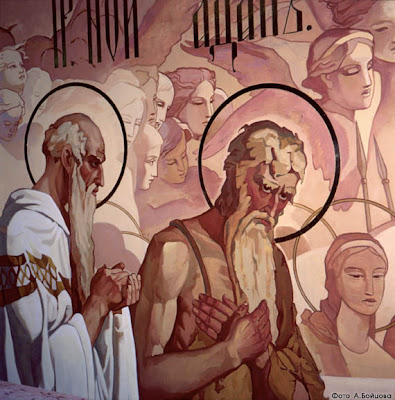The Cathedral of Christ the Savior in Moscow, Russia,
was built, in the words of Tsar Alexander I, to express gratitude to the Savior for Napoleon's retreat from Moscow in 1812. After the death of Alexander I, his successor, Tsar Nicholas I, his brother, did not like the location or design. So the location and design were changed. The revised design was modeled after
Hagia Sophia in Istanbul, Turkey, and the church was built just a few blocks from the Kremlin.
 |
| The Kremlin from Christ the Savior - along the Moscow River |
 |
| Peter the Great statue at the confluence of the Moscow River and Obvodnoy Channel. |
 |
| Christ the Savior in background, St. Basil's in foreground, the Kremlin in the middle. |
The cornerstone was not laid until 1839 and the building, itself, was not completed until 1860. The interior took another 20 years. The cathedral was finally consecrated on the day Alexander III was crowned, May 26, 1883. The naos had a two-floor gallery, with walls of marble, granite and other stone. The ground floor was a memorial to the Russian victory over Napoleon. After the death of Lenin, Stalin decided he wanted to use the site of the cathedral to build a monument to socialism. The church was demolished on December 5, 1931.
 |
| Demolition in 1931 |
It took a year or more to remove debris from the site and marble from the cathedral was used in the Moscow Metro stations, which we visited.
 |
| Moscow Metro Station |
Marble high reliefs (where more than half of the mass of the sculpted figure projects from the background) from Christ the Savior were moved to the Donskoy Monastery in Moscow where they are still preserved. Because of funding problems, flooding of the Moscow River and war, the monument to socialism was never built. In February 1990, after the fall of the Soviet Union, the Russian Orthodox Church, working with Moscow Mayor, Yuri Luzhkov, got permission from the Russian government to rebuild the cathedral. The new cathedral basically follows the original design, but it used modern building materials and other modern amenities. As an example, the high reliefs that were originally marble were modified to be bronze, my favorite part of the building. Here is an example of one of the marble high reliefs
and then its bronze copy now on the outside of the building.
I like the bronze even more than the marble. Following are more bronze high reliefs from the outside of the building.
 |
| Two angels rest above a window. |
 |
| Figures standing above a door. |
 |
| A nice spot to sit. |
 |
| Nativity scene. |
Other decorative pieces on the outside of the cathedral.
 |
| Details from a door. |
The completed Cathedral of Christ the Savior was consecrated on August 19, 2000.
 |
| Christ the Savior with Moscow River in foreground. |
It is the tallest Orthodox Christian church in the world. The first Russian President, Boris Yeltsin, lay in state in the cathedral in 2007 before he was buried in Novodevichy Cemetery. More recently, the punk-rock group Pussy Riot staged an unauthorized performance in the Cathedral on February 21, 2012. In August, three of the members of the group were convicted of hooliganism and sentenced to two years in jail. Pictures cannot be taken inside the cathedral, so I have posted some pictures from the
church website.
 |
| Central dome. |
 |
| Detail from the central dome. |
 |
| More detail from the central dome. |

































Those bronze reliefs are spectacular. My favorites are the angels resting on the windows and the nativity scene.
ReplyDeleteSo interesting to compare and contrast what we've seen in Europe with these buildings. Like John mentioned on an earlier post, I've always wondered what the insides of these churches are like-it seems we see lots of onion dome pictures, but few inside pictures. Wonderful!
ReplyDeleteI visited this cathedral in September 2012, and saw the most impressive nativity scene there. Unfortunately no photographs were allowed, and I have been unable to find any photos on the various web sites. Can anyone help?
ReplyDelete